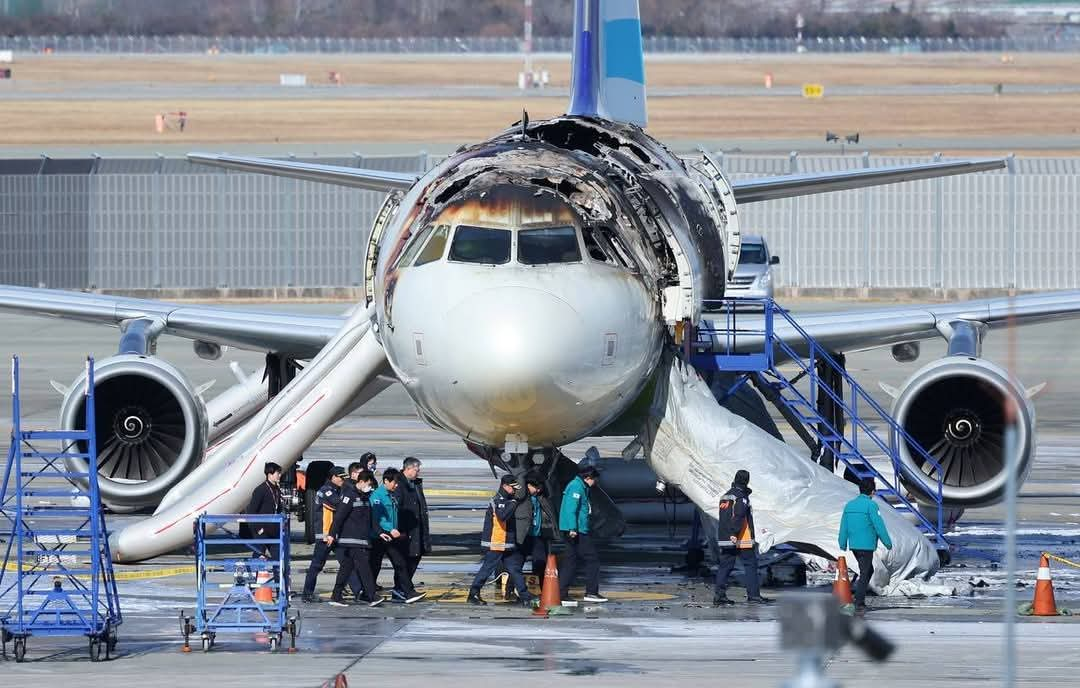


A recent fire from an Air Busan passenger jet is prompting calls for the swifter launch of a converged low-cost carrier (LCC) supervised by Korean Air, as local LCCs’ continuous involvement in accidents raise doubts on their safety management systems, according to industry officials, Monday.
Originally, Korean Air planned to maximize 'efficiency' by integrating Air Seoul and Air Busan, centering on Jin Air. However, following the Jeju Air crash at Muan Airport last month and the recent Air Busan LCC accident, a revision of the 'integrated LCC' model became inevitable.
The cause of the fire is still unknown, although some people raised the possibility that the fire was caused by a portable battery or other items stored in an overhead compartment.
Calls are also growing for stricter regulations on transporting batteries aboard commercial flights following Tuesday's Air Busan plane fire, which is suspected to have been caused by a battery in a carry-on bag stowed in an overhead compartment.
Some airlines have already started making in-flight announcements, asking passengers to keep batteries with them, rather than stowed away in overhead bins.
Since May 31 last year, Korean Air has been encouraging passengers to keep lighters and batteries with them, broadcasting the message five minutes before takeoff.
The fire, which erupted on Jan. 28 from an Airbus A321 aircraft at Gimhae International Airport in Busan, came only about a month after a deadly Jeju Air plane crash claimed 179 lives in December.
An investigation is underway to find the exact cause of the latest fire, but the sequential accidents from major LCCs here escalate safety concerns.
Air Busan is in the process of integration with Jin Air and Air Seoul ahead of the upcoming launch of the so-called converged Jin Air. The merger comes in response to Korean Air’s acquisition of Asiana Airlines. The three LCCs are subsidiaries of the two full-service carriers.
Korean Air is set to finish the launch of the single entity in two years. But the continuous LCC fiascos spark the need for a faster launch of the converged Jin Air.
The blueprint was to become the number one LCC in Korea once the integration is complete, with a total of 58 aircraft, surpassing Jeju Air (41 aircraft), the current number one LCC in the industry.
The longer the LCC integration process is delayed, the greater the financial burden is expected to be. If the three LCCs operate independently, overlapping costs will increase and individual competition over similar routes will inevitably weaken market competitiveness.
Industry officials argued that customers’ uneasiness over LCCs will be alleviated to some extent after the launch of the single LCC with its overall safety management system that Korean Air will supervise.
“Passengers’ distrust in LCCs is reaching its peak, so their top priority is to reduce the sentiment, and for now, the most efficient way to do so is to launch the new LCC as soon as possible,” an official from the aviation industry said.
In December last year, Korean Air shared its cutting-edge flight control system with Asiana Airlines, as part of its first priority to maintain their unilateral safety management structure.
Other industry officials pointed out that LCCs should increase their investments in aircraft maintenance and safety infrastructure, but this would be tough due to their weak profitability compared with Korean Air and other overseas full-service carriers.
“When Air Busan is merged with Jin Air and they share the same safety systems, passengers’ fear sentiment will decline,” the official said.
Busan Metropolitan City and local firms there holding a stake in Air Busan are still protesting its merger with Jin Air, as they hold about 16 percent of Air Busan shares, unlike Air Seoul which is fully controlled by Asiana Airlines.
According to the aviation industry on the 31st, Korean Air was finalizing the acquisition process for Asiana Airlines this month and was planning to launch an integrated LCC within two years.
Aircraft maintenance can also be relied on by Korean Air. Korean Air is expanding Asia’s largest MRO (Maintenance, Repair, Overhaul) facility, aiming for operation in 2027.
Once the new plant is completed, the number of engines that can be serviced will increase 3.6-fold from 100 to 360 per year, and new engine models will also be available for maintenance by Korean Air.
You may like to read......
